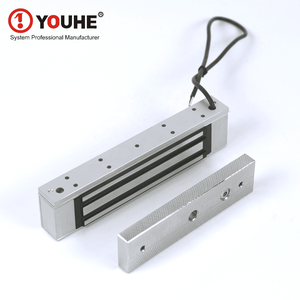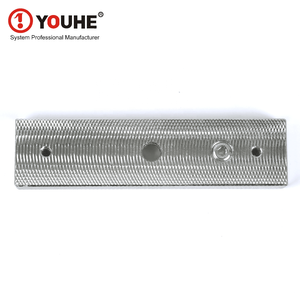
All categories
Featured selections
Trade Assurance
Buyer Central
Help Center
Get the app
Become a supplier

(4411 products available)







































Doors can use several electromagnetic door lock types, depending on the purpose. The various locking systems include the following:
Deadbolt Electromagnetic Door Locks
As a powerful locking system, the deadbolt electromagnetic locking system can secure any door. When the bolt slides into the doorframe, this locking system locks the door and prevents it from being easily forced open. Such functionality is ideal for places with sensitive information and valuables. The operating principle states that the locked position occurs when an electromagnetic current is applied to the lock. In security areas, deadbolts are often used as additional locking mechanisms.
Vertical Bolt Electric Locks
When the installation of a vertical bolt electric lock is performed on a door, the locking system will extend top to bottom. It will increase the locking security for heavy traffic, high security, and emergency doors, like those found in banks, data centers, and commercial warehouses. The vertical lock bolt engages two or more points to improve the security lock by extending vertically up and down into the door frame.
Magnetic Lock System
As the name may suggest, magnetic locks use the magnetic principle. These locks consist of an electromagnet installed on the door frame and a metal plate on the door. When electric current is passed through the electromagnet, it creates a strong magnetic force that pulls and holds the metal plate. This system is easy to install and is widely employed in commercial settings.
Retraction Electric Locks
Interaction electric locks are often installed on doors with panic bars and push bars for exit. These locks automatically retract the locking bolt when an access control device, such as a card reader, is activated. It allows quick and easy exit while still securing the door when locked. Common installations are in schools, hospitals, and commercial buildings.
Electromechanical Locks
It is a hybrid locking system that combines mechanical locks with electromagnetic locking features. These locks allow mechanical keys and electronic access control, so they offer extra flexibility in security. Electromechanical locks are commonly used in facilities requiring multi-level security access.
Strike Lock System
This locking system is similar to electromagnetic locks above but with a strike plate and electric strike lock instead. Electric strikes are installed in the existing mechanical lock and controlled by an access control system. The doors can be open or closed by releasing the lock mechanism. This electric strike lock installation is ideal for retrofitting existing secure doors.
Commercial Buildings
Commercial buildings, such as office complexes and retail stores, have traffic volume and require different access control solutions. An electromagnetic door lock system is commonly used for securing main entrances, restricted areas, and server rooms. They provide durability and minimal maintenance required. Magnetic locks can easily integrate with the electronic access control system.
Industrial Facilities
The industrial factories damaging work environment, including chemicals, heavy machinery, and extreme temperatures, have all been created. So, safety is the main priority. For safeguarding the valuable assets and withstanding the harsh environment, horizontal and vertical electric locks are best suited here. These locks are commonly used to secure warehouses, manufacturing plants, and work areas with sensitive equipment.
Institutions
Schools and hospitals require security and easy access simultaneously. An electromagnetic door lock system installed in schools can restrict access to areas such as laboratories and staff rooms while providing an easy exit during emergencies. Similarly, hospitals can secure drug storage rooms, patient record areas, and other restricted areas while allowing smooth and safe access during emergencies through retraction locks.
Government and Military Facilities
These facilities deal with sensitive information and resources; hence, top security is required. In these places, electromagnetic locking systems are used on classified areas, data storage rooms, and weapon storage depots. Access control systems protect these locks using advanced access control systems like biometrics and key cards.
Residential Properties
Residential properties are increasingly adopting electromagnetic locks. These locks offer convenience and high security for home owners. An electric strike lock system is often used to secure the entrance doors integrated with intercom systems or smart home technology. This allows remote and authorized entry for guests or services while keeping the detailed record for enhanced security.
Public Infrastructure
Public infrastructure, like airports and transit systems, also employs electromagnetic locks to ensure passenger and luggage safety. These locks are installed in restricted areas such as baggage handling, maintenance, or secure storage rooms. Easily integrated with an access control system, these locks can manage high security while affording quick access during peak times.
High Security
Electromagnetic locks, sometimes called magnetic locks, are among the highest types of door locks. Because these locks are mounted to the door and frame, forcing the lock to open becomes difficult. The magnetic force used to hold the door securely is very great, so these locks are very difficult to tamper with. This is why they are best suited for areas requiring high security, like banks, data centers, and restricted military zones.
Durability and Reliability
Magnetic locks are designed for heavy usage, especially in commercial and industrial environments. They have no moving parts, so the chances of wear, mechanical failure, or breakage are very slim. This leads to locking systems that provide reliable security for many years, especially in harsh conditions.
Easy Integration with Access Control Systems
The electromagnetic locking system integrates easily with various access control systems, including key cards, PIN codes, and biometrics. This capability is useful because, with today’s advancement in technology, these locking systems can be operated and monitored through mobile applications, giving such an area additional protection and assurance through remote capability.
Fail-Safe Operation
These locks are designed to lock the door when a power failure occurs. It is highly advantageous in emergencies, such as fire or natural disaster. Emergency procedures will allow the easy opening of the locks during a power failure or any situation implying magnetism is released. Doors can be freely opened. Businesses or organizations require many controlled access points and the easy flow of foot traffic. For example, airports, hospitals, schools, etc., electric strike locks are used. Electric strike locks are great for increasing both security and efficiency.
Low Maintenance
The electromagnetic locking systems have no moving parts like traditional locks; they do not require much maintenance. This means there is no need for frequent lock lubrication or mechanical part inspections. This characteristic makes it a desirable locking solution as it uses a small amount of resources for maintenance and monitoring while increasing its reliability in keeping an area secured, especially in commercial contexts where easy operation requirements come in.
Scalability and Flexibility
Electromagnetic locks can easily scale, meaning that as an organization grows or changes, additional locks or access points can be added without a complete overhaul of the existing system. This flexibility makes them appropriate in ever-changing environments, such as large facilities with fluctuating security needs.
Security Needs Assessment
The first step in choosing any electric door lock is to assess the security needs of the installation site. Low-traffic areas like data centers may need higher security locks than average commercial offices. One must also consider the types of secured assets, be they physical or digital, and the potential threats. After this, one can select a locking mechanism that enough secures meets these needs.
Door Compatibility
One factor to consider when choosing any door lock is which door frame and material it will be mounted on. Based on the types of doors, the horizontal or vertical bolt electric lock or magnetic locks may be more suitable locks for thick metal or glass doors. While selecting a lock, ensure it is compatible with this feature since improper installation on any frame may cause vulnerabilities.
Type of Lock
Various electric locks are available, and each has advantages: magnetic locks are excellent for areas where silent locking is needed, and the retraction electric lock is suitable for emergency exit doors. A deadbolt electromagnetic door lock provides extra security. Understanding the purpose will make it easier to choose the right one.
Access Control Integration
How well an electric lock system will integrate with the existing access control system must be thought of. Many modern locks tend to be inline with key card systems, biometrics, PIN codes, and other forms of identification. This can ease the manner of operations and at the same time provide more convenience. One should choose a lock that offers flexibility in the form of access.
Durability and Reliability
Durability is important, especially in high-traffic areas. A lock should be installed to withstand constant use and any environmental factors it may undergo. Magnetic locks are for their durability; however, proper verification of locks when purchasing is required.
Fail-Safe and Fail-Secure Options
Consider what types of operations are performed in the facility to choose an appropriate electromagnetic door lock. The fail-safe lock mechanism ensures that the door will open in case of a power failure. It is appropriate in environments where emergency evacuation procedures need to be followed. However, a fail lock mechanism is required in areas that need constant security when locked since it will lock the door when there is no power.
Cost vs. Long-Term Value
There is a variety in the price of electromagnetic locks, and each varies according to the quality and functionalities it proposes. These locks should be evaluated based on their durability, maintenance needs, integration capabilities, and efficiency in power usage. While it can be tempting to choose the least expensive, always compare costs and long-term value.
Several electrical locks for doors are called magnetic locks. These locks comprise an electromagnet and a metal plate glued to a door. When electric current is passed through the electromagnet, it creates a magnetic force that pulls the metal plate and holds the door tightly. This is called locking. When the current stops, let’s say due to a power outage or when the lock is opened, the magnetic force disappears, and the door can easily be opened.
Magnetic locks have several advantages. They provide high security, as they are hard to tamper with. They are also very durable since they have no moving parts, so they require less maintenance. Furthermore, they can easily be integrated with advanced access control systems like key cards and biometrics for extra security.
Yes, electromagnetic locks can be installed outside. However, one should select weatherproof models. Weatherproof locks are designed to withstand rain, snow, and extreme temperatures. They are coated with materials that prevent rusting and corrosion.
While traditional locks can easily be picked or bumped, magnetic locks are hard to tamper with because they are mounted to the door and frame. This provides more security, especially in sensitive areas like banks and data centers. They are stronger in force, around 1,200 pounds, than regular locks.
Using an electro-mechanical lock with existing emergency exit systems, like fire exit doors, is possible and beneficial. These locks allow quick unlocking of doors during emergencies while maintaining security.